I’d just driven over a landmine. As I brought the Humvee to a stop, we found ourselves surprisingly unscathed yet located—in all likelihood—smack dab in the middle of a minefield.
With no margin for error, we kept calm, evaluated our options, and chose the least awful exit plan. I slowly backed over the unexploded mine, steering in reverse along my original tire tracks while paying the utmost attention to every minutiae. We got lucky that day.
Years later, after I’d left Iraq and Kuwait and transitioned out of the military, I worked in instructional design. Our team was hosting a highly visible internal training webinar. We had senior leaders watching, presenting, and attending. But shortly after the event began, technical difficulties brought the whole thing to a halt.
A sense of panic spread. But I fell back on my training and went into troubleshooting mode. I knew how to stay calm under fire, a skill I’d honed on the battlefield.
We got that webinar back online. Getting myself to a point in my career where I could succeed in the private sector wasn’t so easy, however. For former service members like myself, the path to civilian employment is often fraught with uncertainty at nearly every step.
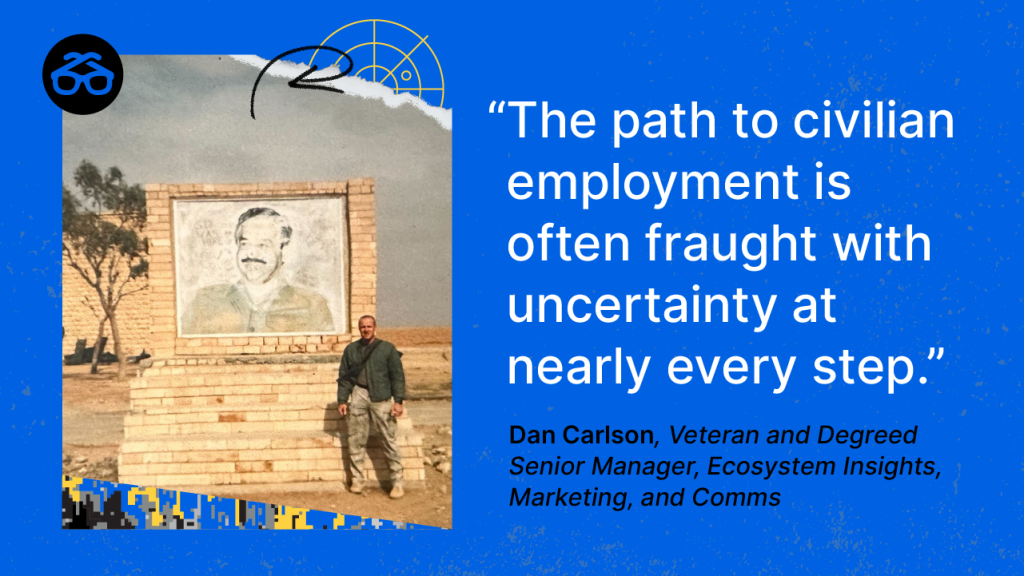
We all can do more to help veterans—business and L&D leaders alike.
Transitioning from military work and life to civilian work and life is a challenge faced by 200,000 military personnel who leave the U.S. armed services annually. That equates to nearly 550 people every day.
An alphabet soup of federal agencies including The Department of Veterans Affairs, and The Department of Defense provide a wealth of support through 45 government programs.
“Helping veterans overcome challenges to transitioning to civilian life—such as unemployment, homelessness, mental health issues, and disability-related issues—is essential,” according to the U.S. Government Accounting Office (GAO). “However, agencies could improve some of these supports and services.”
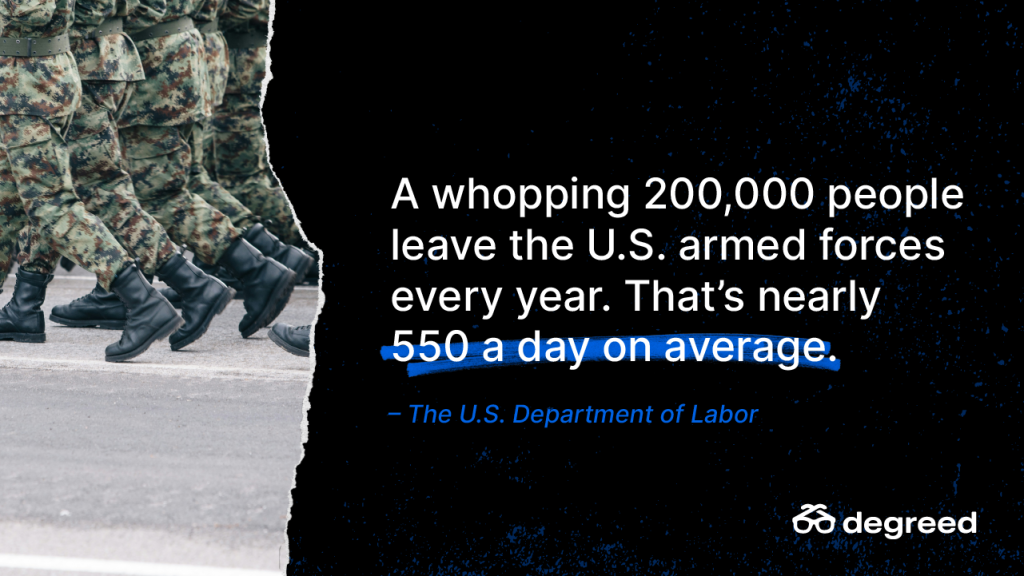
In some cases, lackluster outreach, stifled collaboration, deficient monitoring and data, and ambiguous goals hamper the success of the federal assistance programs, according to the GAO.
In addition, a wide range of state programs and nonprofit groups including the Veterans of Foreign Wars (VFW) provide similar services. For many former service members, admirable initiatives like Civilian Ready, Veterans Transition Support, and Fourblock are lifelines to a new life chapter.
Like any newly-hired employee—whether it’s someone fresh out of college or already in the civilian workforce who’s coming from another company—newly-hired, transitioning veterans need support. They’re acclimating to not only civilian sector norms but also an unfamiliar company culture as well as the unique expectations of their new workplaces.
As company culture champions, business leaders and L&D pros are well positioned to help vets acclimate. And they’re increasingly recognizing the benefits of hiring former service members.
Still, business leaders and L&D pros can do more.
Military skills are transferable skills.
For the tens of thousands of veterans facing the uncertainty of what’s next, it’s important to understand that identifying transferable skills, and then explaining how they’re transferable, is critical to career reinvention.
If you’re in L&D, there’s a big insight for you in that statement.
For starters, L&D leaders can lend support to their HR colleagues and promote an expanded, skills-first approach to hiring veterans.
As the analysts at McKinsey & Co. recently noted, “Traditional ways of hiring make it harder for many service members to land civilian jobs.”
However, “A hiring strategy that focuses on expanding the pool of potential talent can help communities by creating more and better job opportunities for a broader, diverse pool of workers. It can also provide upward mobility for millions of workers—including veterans—at a crucial time for the U.S. economy.”
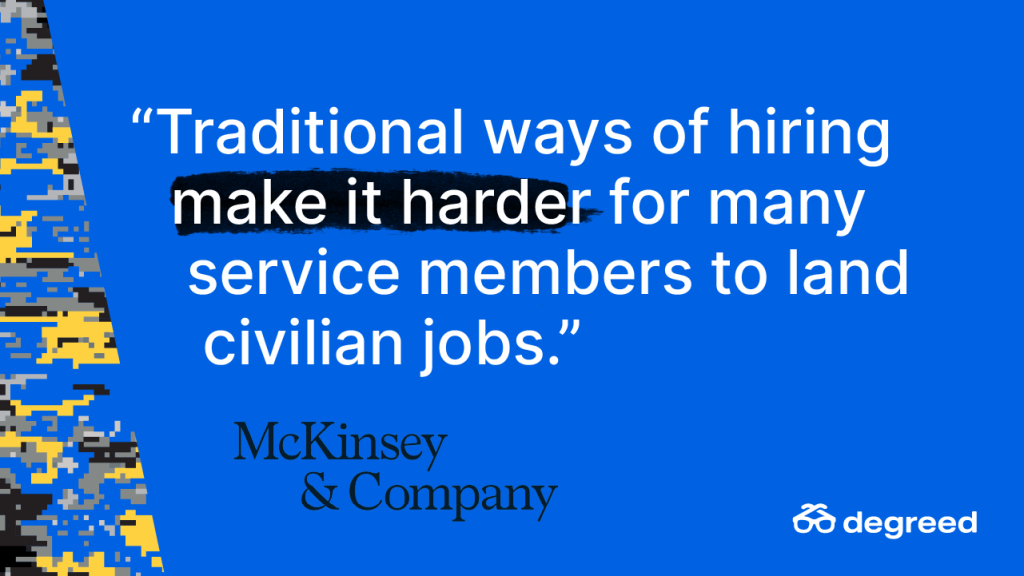
Perhaps more importantly, L&D can create focused learning experiences that help former military members refine, expand, and apply the transferable skills they bring. The more L&D works with veterans, the more businesses will realize former service members are highly trainable. Why? If there’s one thing the military does well and a lot of, it’s train. We were constantly training. In modern day civilian terms, we were constantly upskilling and reskilling.
By embracing skills-first employee learning, companies “can build skills and retrain their existing workforces to prepare people for new roles,” McKinsey said. “Retention improves when workers find more opportunities to advance internally. Skills-based practices have a greater impact when they’re implemented across the whole talent journey, including in sourcing, hiring, and career development.”
Leaving the military wasn’t the only decision I faced.
When I separated from the U.S. Air Force, Security Forces with an honorable discharge in 2008, I had obtained the rank of E-6, or Technical Sergeant. It’s part of a grouping of ranks referred to as Non-Commissioned Officers (NCOs) who are also leaders. Along the way, I attended some of the world’s best leadership academies.
During my 10 years in the service, I led teams in daily state-side operations as well as combat operations in Iraq during the 2003 U.S.-led offensive. I also completed two tours in Kuwait. All told, I completed seven overseas tours including six in the span of three years.
Air Force Security Forces are responsible for safeguarding base entry points, flightlines including runways and tarmacs, aircraft, conventional and nuclear munitions, and all the people and other physical resources on a base. During my tours, we also provided off-base buffer zone patrols, convoy escorts and security to and from Kuwait City International Airport.
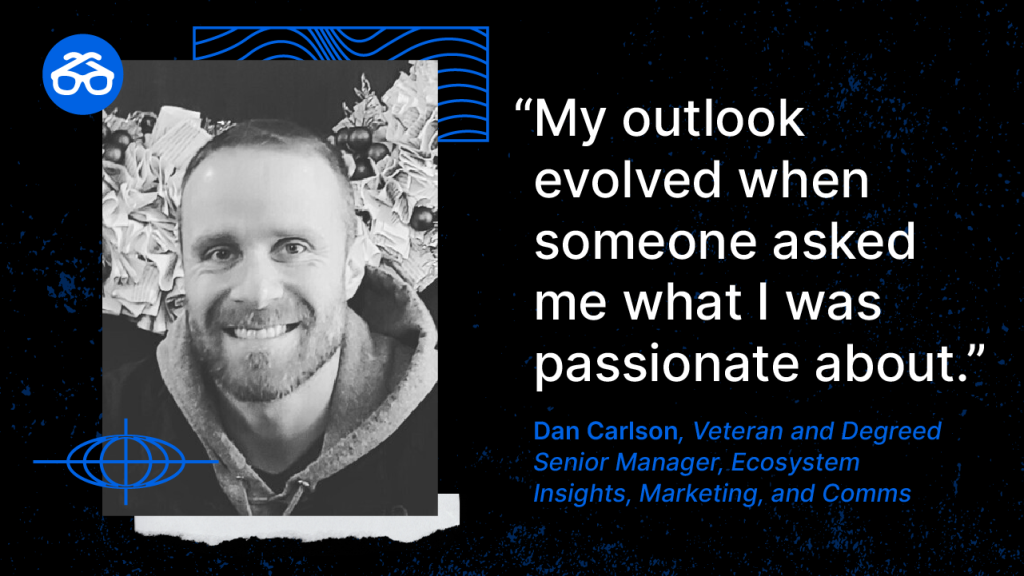
In the second half of my military career, I taught basic and advanced ground combat tactics at the U.S. Air Force Security Forces Academy in San Antonio, Texas.
As I approached my seven-year mark, I thought about my future. Would I reenlist? If I did separate, what would I do? I considered a civilian police force or private security, but realized I was doing those things already.
My outlook evolved when someone asked me what I was passionate about. It was an easy question to answer. I’d always loved any kind of technology. And in my final years in the Air Force, I had also found a passion for teaching. That’s when I was introduced to the field of educational technology. I decided to make edtech, which married my passions, a big part of my future.
I would have loved more guidance early on.
My out-processing included a few classes on resume writing. They covered the differences between military and civilian writing, “business professional” and “business casual” dress, and common pitfalls to avoid like jargon or swearing.
While there were some good tips, those classes left a lot to be desired. I found some resume writing services in the private sector, but they were beyond my personal price range. Fortunately, I had a network of accomplished civilians around me who helped tweak my resume from military to civilian speak.
I also knew I needed formal education. That was (and all too often remains) the currency upon which talent is hired. I already had two associate degrees, one in criminal justice and another in technology and military science. But I knew those wouldn’t be enough. Indeed, I didn’t think a bachelor’s degree would even be enough, so I set my sights on a master’s degree.
Within three years I earned a bachelor’s degree in occupational education, focusing on criminal administration, and a master’s degree in educational technology. Ironically, this is where I began to learn that a degree was just a ticket to ride.
Civilian work challenges roiled me.
I quickly realized culture was the biggest difference between military and private sector employment.
In the military, I was in a position of leadership, so I was expected to speak clearly and directly to avoid misunderstandings and confusion.
After the military, I continually received feedback that I was too direct, which came off as harsh. I was shutting down conversations before they had a chance to get started, because I was quick to share my opinions when asked. My input wasn’t always well received. It was considered brash and authoritative and closed off to counterpoints. I had to soften my approach.
Then came the challenge of explaining my military experiences during civilian job interviews. Clearly connecting my ability to shoot at long ranges and clear buildings in urban environments to designing elearning and hosting webinars was unsurprisingly difficult.
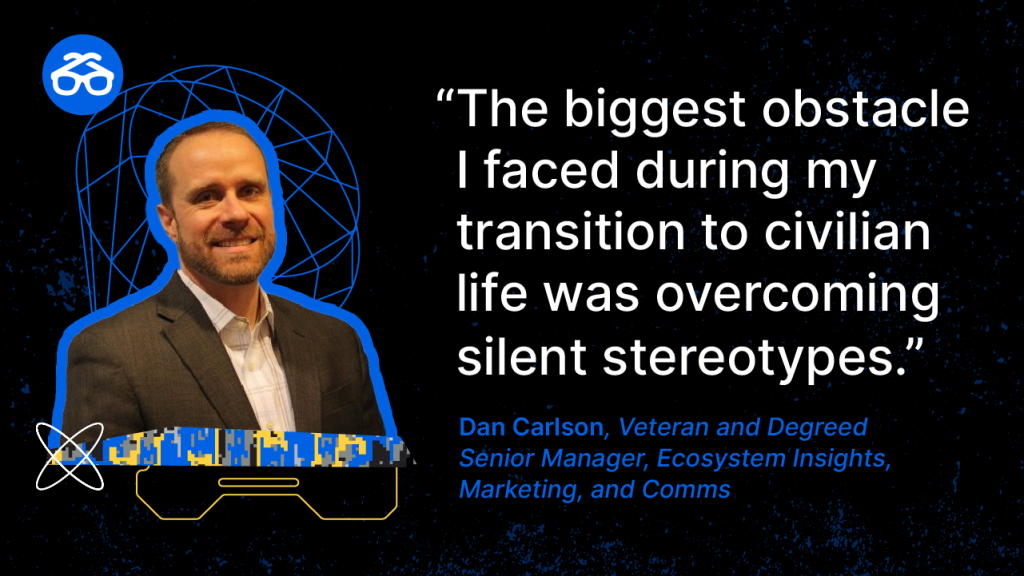
I wouldn’t realize until years later that the biggest obstacle I faced during my transition was overcoming silent stereotypes of the military. Many civilian recruiters and hiring managers considered officers educated leaders and relegated enlisted personnel to less educated, less refined order takers. In my experience as an enlisted, noncommissioned officer, that equated to less desirable.
I don’t entirely blame recruiters or hiring managers for the misperception. It’s a byproduct of simply not having much if any experience with former military members. After all, less than 1% of all U.S. adults are active-duty service members and, in 2022, only about 6% of the U.S. adult population was veterans.
I had to learn to tell my transferable skills story.
On the day I drove over that mine, we headed off base in the afternoon, crossed some open desert into nearby oil fields, and traveled toward an old, abandoned police outpost. There wasn’t anything special about our Humvee. It wasn’t armored, and we probably had the doors off to counter the heat of the day.
I caught a glimpse of something dark shaped like a large dinner plate in the sand. But by the time I saw it, it was too late. We had to assume it was not random ordnance. How deep we were into the minefield was anyone’s guess.
And so, we had a decision to make. Drive forward? Turn around? Retrace our tracks and drive over the mine again?
To be a good leader, you also have to be a good follower. You need to work with others to overcome challenges like we did that day in the desert.
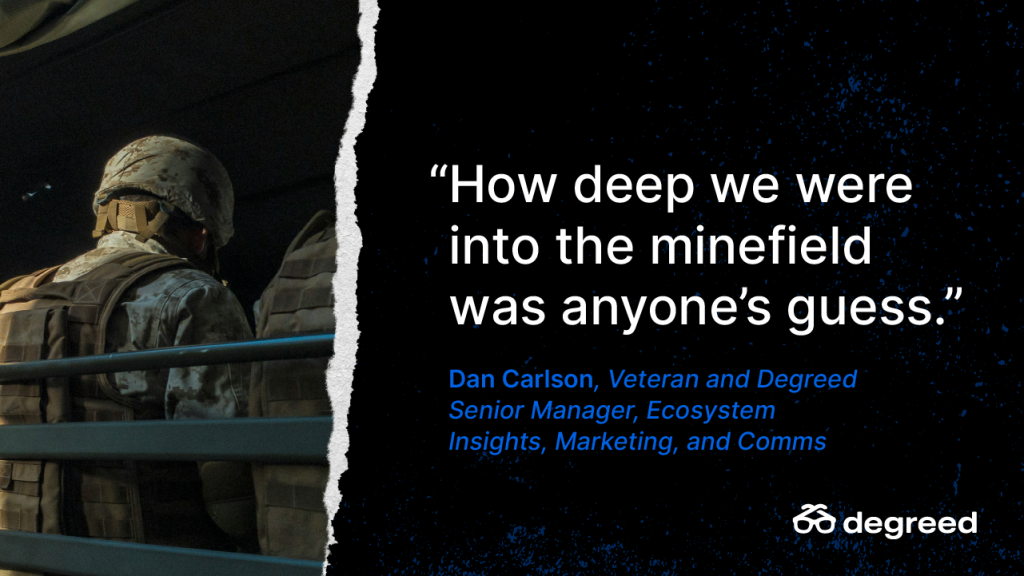
As my civilian career progressed—as I made more connections, had more job interviews, and got more feedback along the way—I realized that talking about my skills in ways that highlighted how transferable they were made a huge difference.
Every advanced combat and specialty school I ever attended wasn’t really about advanced tactics. Obviously, we learned new things and practiced those new tactics, but it was more about leadership. Can you lead, whether formally or informally, under harsh and stressful conditions, with little to no sleep, food or water for days on end?
To lead and operate as part of a team requires discipline and an unwavering work ethic. To survive in an environment where anything that can go wrong can and usually will go wrong demands problem-solving and adaptability. Communication and decision-making are equally critical.
More and more, I extrapolated transferable skills from my experiences.
Veterans, learn to tell your skills story.
Explain how your military skills translate to the civilian sector, because they are 100% transferrable and relevant.
Part of that story will be written on a resume, and there are so many more options to help with that than there were 15 years ago, from Microsoft Word templates and generative AI tools to thought leadership posts on LinkedIn and even professional resume writers.
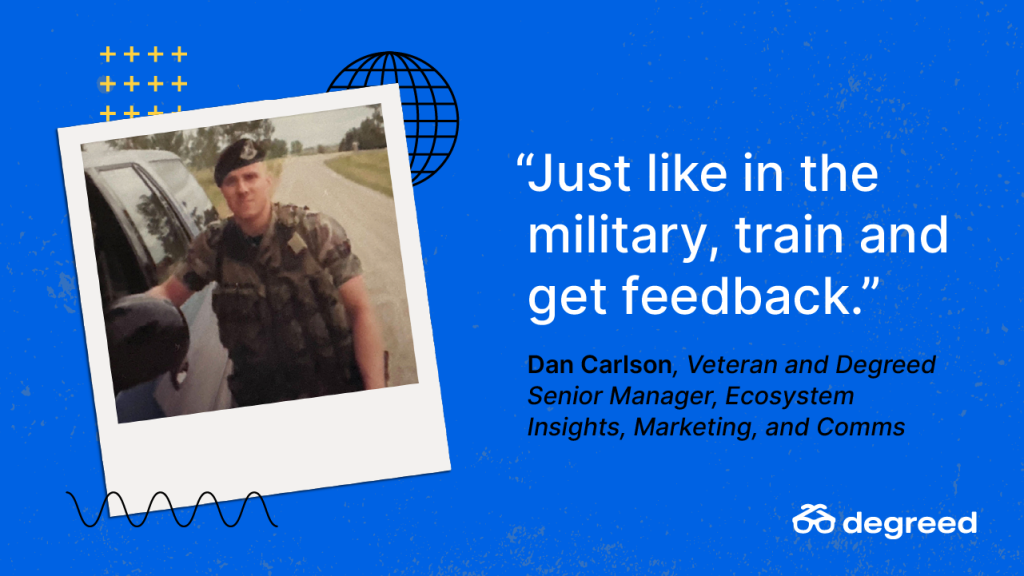
Just like in the military, train and get feedback. Use LinkedIn to find veteran groups and other veterans, and don’t be shy about asking for help. Connect with anyone who will listen as you practice sharing your transferable skills story out loud. Ask people to pay attention to your tone and the phrases you use. Military people like you sometimes have a way of speaking you might not always be aware of.
Hiring managers, listen below the surface.
Think more broadly about who you’re evaluating for new positions. Past experiences can serve as valuable indications of future performance. When evaluating former military personnel, or anyone for that matter, think about what people’s past experiences can tell you about their infinite potential.
I can do more than drive a vehicle in and out of a minefield. That was luck. But I can remain calm in a high-pressure situation. I can think critically and formulate a plan of action on my feet. I can consider options based on their merits, adapt, and act. I can lead.
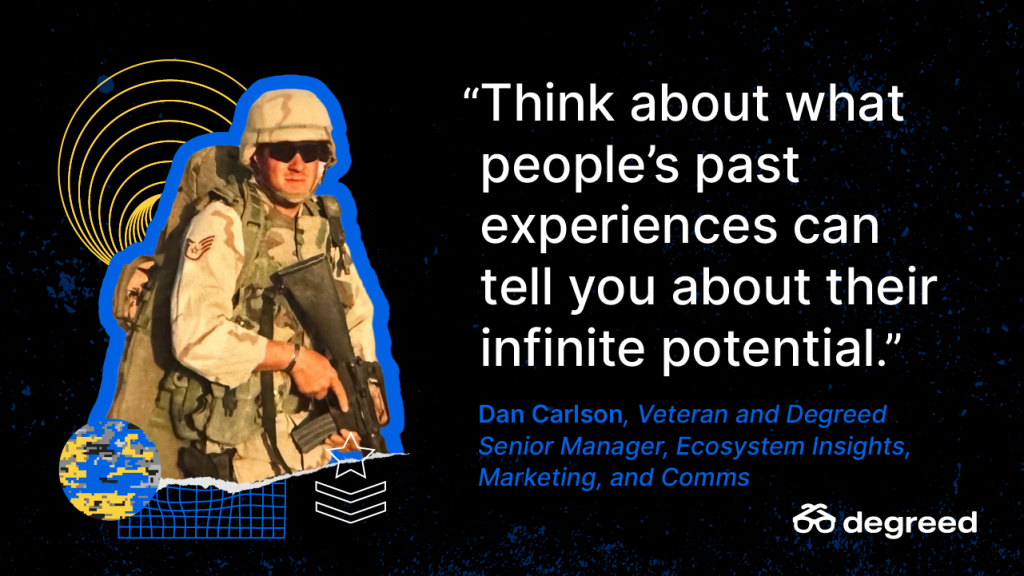
Decipher those types of skills and you’ll find the talent you’re looking for. Remember, you can teach business practices, specific product knowledge, and PowerPoint. But you can’t teach potential, tenacity, or unwavering commitment.
Think about the value in someone capable of following orders and executing a plan. Whether the person was a commissioned officer or a noncommissioned officer, or even a lower rank, they have experiences and resilience forged in some of the toughest environments imaginable, and that doesn’t always mean hostile combat.
L&D pros, create space for trial and error.
People gain knowledge by consuming content—courses, articles, books, podcasts, lectures, and more. They’re always learning.
Workers gain skills by taking their newly-acquired knowledge and putting it into practice.
My favorite illustration of this dynamic goes like this: Who would you prefer perform your operation? The recent med school grad or the hand with 10 years surgical experience? They’re both doctors, so what’s the difference? The difference is skills acquired and honed through practice.
People build skills through practical application guided by a supervisor, a mentor, or a more knowledgeable, seasoned expert. Apply that to your instructional designs. Develop experiences alongside your instruction and create space for learners to try, make mistakes, fail, and then try again. That’s when knowledge is transferred and begins to morph into a skill.
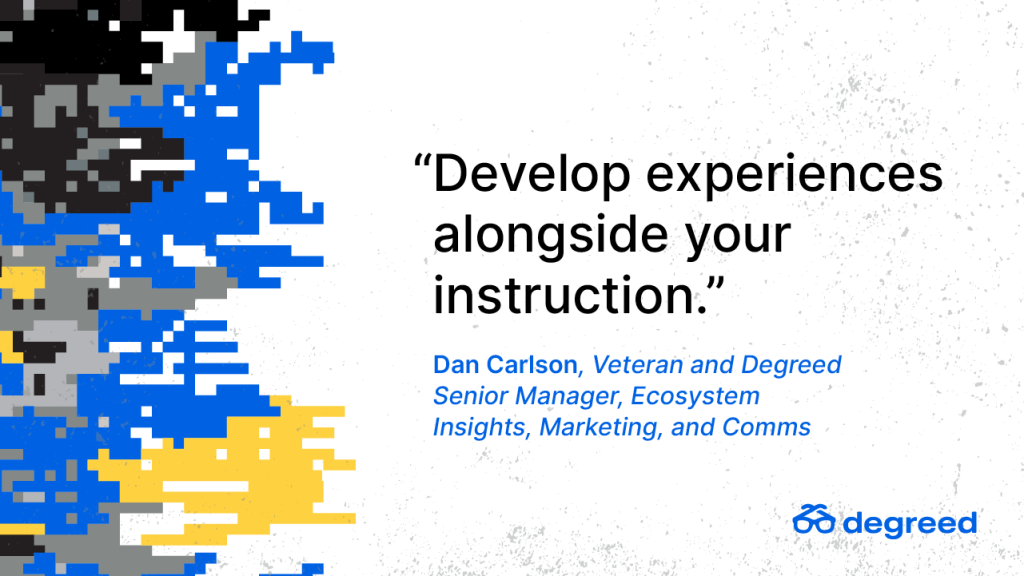
As an instructional designer, instructor, and learning consultant, I witnessed the most significant changes when my students put knowledge into practice. Asynchronous learning opportunities can disseminate a lot of information, but it’s workshops and academies that drive meaningful behavior change and skill building.
Veterans are accustomed to upskilling and reskilling on the job. A new assignment? An entirely new career field? Unlike many businesses, the armed services makes time during work hours for people to reengineer themselves. As a result, the veterans at your workplace might be uniquely positioned to embrace upskilling—and even help you think through and design experiential learning programs at your organization.
Remember, we’re all more than just one thing.
Sometimes it’s hard to believe I’ve been out of the military for longer than I was in. While that time is firmly in my past by more than 15 years, it’s shaped who I am as a person, dad, partner, friend, and professional.
If there’s one thing my career journey has taught me, from the military to marketing, it’s that we’re all more than our degrees. We’re more than our skills. We’re more than our failures. We’re more than our successes.
We’re tenacious creatures capable of immense growth and adaptability.
When learning leaders believe this about their people, especially veterans who might need some extra support, there’s no stopping them.
Degreed Content Manager Tom Schultz contributed to this blog post.
